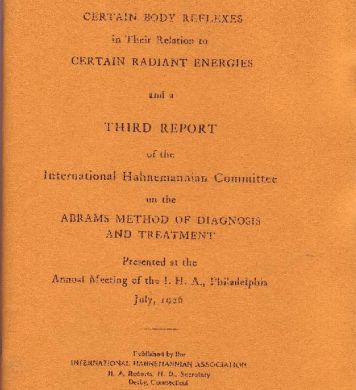Certain Body Reflexes
Certain Body Reflexes in Their Relation to Certain Radiant Energies and a Third Report of the International Hahnemann Committee on the Abrams Method of Diagnosis and Treatment; Presented at the Annual Meeting of the I.H.A., Philadelphia, July, 1926

The Hahnemann Committee, a prestigious organization of homeopathic Doctors and electrical and mechanical engineers take a look into the Radionic system of Dr. Albert Abrams.
This is a great example of a living document that will transport you back in time to 1926 allowing your mind to soak in the first hand impressions and observations of empirical investigators on the borderland of perception.
Stapled: 46 pp
Language: English
Product Code: B0011
Price: $15.95
Excerpt:
HISTORICAL ASPECT
Although the phenomena under discussion have had widespread attention for only a few years, various observers have both inductively and deductively considered them. The work of this committee and the work of Boyd have both been connected with the energy inherent in Homeopathic dilutions.
In so far as the body reactions are concerned, they were probably first observed by Albert Abrams and George Starr White. Whether both observed them independently or not, this committee has no way of knowing.
So far as the energy is concerned, Hahnemann himself deduced such quality in drugs. He considered his discovery of the presence of some sort of energy in high dilutions as the most important of his day.
He spoke of the inherent power in potentized drugs as a “spirit-like” force. The comparison “spirit-like” was apt a term as he could use, for at his time, there were no physical properties known in nature to which he deduced to exist.
He expressed himself more explicitly in the introduction to his proving of the magnet. His use of the term “dynamic power” conveys his concept and he elaborates his ideas more fully in the foot-note to section 2 of the Sixth Edition of the Organon.
In 1851, Reichenbach set forth his theory of an odic or idyllic force. His claim was that there are certain emanations which are emitted from objects such as magnets, crystals, and the human body, metallic conductors, etc., which, when subjected to the sensibilities of certain sensitive persons, cause certain sensory reactions to be received and recorded. He conceived a negative and positive phase of this force.